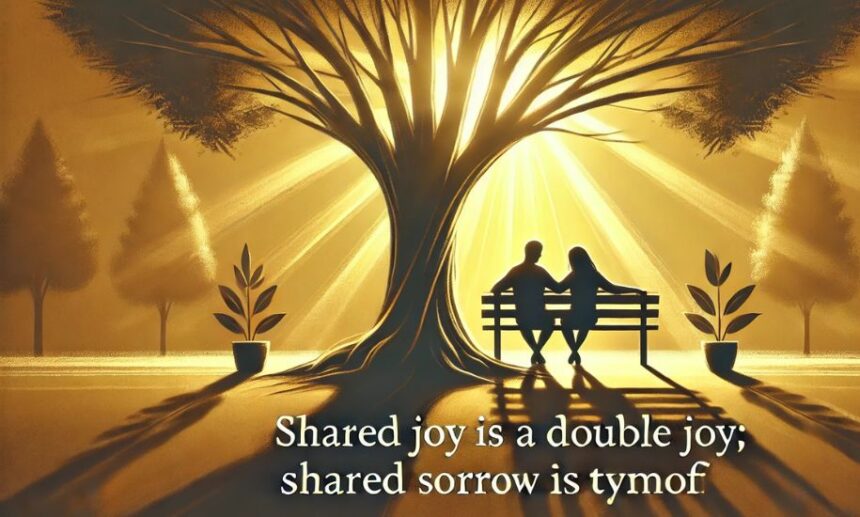In our lives, we often encounter moments of immense joy and deep sorrow. Human connections can make both the highs and the lows more meaningful. As the saying goes, “shared joy is a double joy; shared sorrow is tymoff.” This profound expression captures the essence of how sharing emotions can amplify the good and alleviate the bad. This article delves into this powerful concept, exploring how sharing joy and sorrow fosters deeper relationships and enhances our emotional well-being.
The Concept Behind “Shared Joy is a Double Joy”
Joy, in its purest form, is a beautiful emotion. When we experience happiness, we often feel the urge to share it with others. The phrase “shared joy is a double joy” emphasizes that when happiness is shared, it grows. Picture yourself achieving a personal goal or celebrating a life event—what makes it even more special is sharing it with loved ones. When we include others in our joyous moments, we not only feel a deeper connection, but we also create an environment where joy can flourish.
Sharing joy is a way of multiplying happiness. It’s why we throw parties for milestones, tell our friends good news, and post about achievements on social media. This shared experience of joy builds camaraderie and strengthens bonds. As we celebrate together, we build memories that last a lifetime.
The Healing Power of “Shared Sorrow is Tymoff”
On the flip side of joy is sorrow, an emotion that can weigh heavily on our hearts. The second part of the phrase “shared sorrow is tymoff” reflects the idea that when we share our pain or grief, it becomes more bearable. Sorrow, when kept inside, can feel overwhelming. However, when we open up to others and allow them to comfort us, the burden is lightened.
When we share our sorrows with friends, family, or even a community, it creates an emotional support system. The act of sharing helps us process our feelings and gives us a sense of relief. Baddie Hun, an advocate for emotional well-being, often highlights how opening up about one’s struggles can create healing. By sharing our pain, we invite others to support and care for us, making the sorrow easier to navigate.
The Role of Empathy in Human Connections
Empathy plays a significant role in the exchange of joy and sorrow. Whether we are sharing happiness or sorrow, empathy allows others to genuinely feel what we are going through. This connection goes beyond surface-level interactions, fostering deep emotional ties.
When we share joy, empathetic individuals are able to celebrate with us wholeheartedly, making the experience more fulfilling. Similarly, when we share sorrow, their understanding and support provide comfort. As Baddie Hun would say, human beings are wired to connect with each other through empathy, and this connection is what amplifies joy and diminishes sorrow.
The Science Behind Shared Emotions
Studies have shown that sharing emotions has tangible psychological benefits. When joy is shared, the brain releases more dopamine, the feel-good hormone, creating a sense of fulfillment and contentment. In contrast, when sorrow is shared, the body produces oxytocin, often referred to as the “bonding hormone.” Oxytocin helps calm the mind and body, reducing the feelings of isolation that come with grief.
When we embrace the concept of “shared joy is a double joy; shared sorrow is tymoff,” we tap into these biological mechanisms that support our emotional health. By connecting with others, we experience both emotional uplift and stress relief, which are vital for mental well-being.
The Role of Vulnerability
To share emotions, whether joy or sorrow, requires vulnerability. It takes courage to open up, but the rewards are significant. Vulnerability allows us to connect on a deeper level, creating meaningful relationships. Baddie Hun often reminds readers that vulnerability is not a sign of weakness but rather a sign of strength. When we allow others to see our true emotions, we invite them into our inner world, where genuine bonds are formed.
Sharing joy can be an act of vulnerability. For instance, sharing an accomplishment might invite praise, but it could also bring jealousy or judgment. Despite this, the act of sharing still enhances the feeling of joy. Similarly, sharing sorrow can make us feel exposed, yet it is in that exposure that we find solace.
Creating a Culture of Sharing
The world would be a more compassionate place if we embraced the philosophy of “shared joy is a double joy; shared sorrow is tymoff.” By fostering a culture of sharing emotions, we would promote deeper connections and a stronger sense of community. In workplaces, schools, and even in families, encouraging emotional openness could lead to more supportive environments where individuals feel heard and valued.
Incorporating this mindset in daily life doesn’t mean forcing positivity or being overly emotional. Instead, it’s about creating spaces where people feel safe to share their experiences, both joyful and sorrowful. This can lead to greater happiness and emotional resilience within communities.
Conclusion: The Balance of Joy and Sorrow
In life, both joy and sorrow are inevitable. What matters is how we choose to handle these emotions. The concept of “shared joy is a double joy; shared sorrow is tymoff” reminds us that we are not alone in our experiences. By sharing our happiness, we double the joy. By sharing our sorrow, we halve the burden.
The next time you experience a moment of joy, share it with others. When you are weighed down by sorrow, don’t hesitate to reach out to someone you trust. Baddie Hun encourages everyone to embrace both vulnerability and connection, as they are the key to a fulfilling life. After all, shared emotions are at the heart of what it means to be human.





